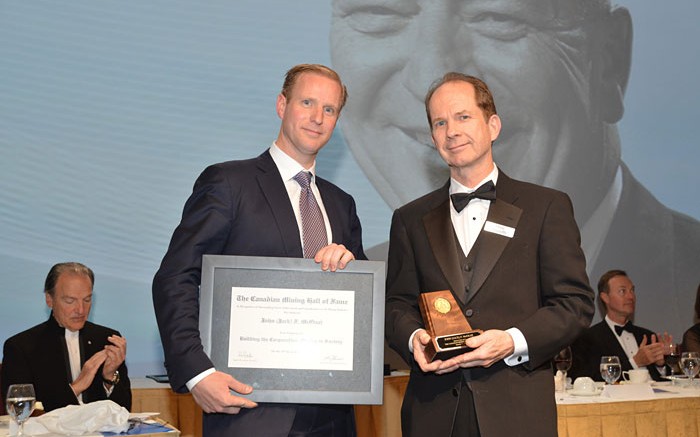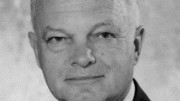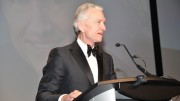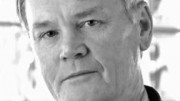Four new inductees boasting outstanding achievements in the diverse fields of mining engineering consulting, modern mineral exploration and grassroots prospecting joined the Canadian Mining Hall of Fame in the twenty-sixth annual ceremony in Toronto on Jan. 16, 2014.
Gold mogul Pierre Lassonde returned to the dais as master of ceremonies and, after a few Rob Ford jokes, said that “we had a great deal to be proud of in Canadian mining” and that it was time to “celebrate the remarkable achievements of these four individuals.”
The chairman of the Canadian Mining Hall of Fame, Hunter Dickinson’s executive vice-president Robert W. Schafer, said that the “collective reach of the inductees across Canada, across the globe and across every aspect of the mining industry is truly amazing.”
The first inductee of the evening was John (Jack) F. McOuat (1933–2013), an icon of the Toronto mining scene and co-founder of the independent geological and mining consulting firm Watts, Griffis and McOuat (WGM).
McOuat was born and educated in Toronto, graduating with a geological engineering degree from the University of Toronto in 1956.
He soon joined Oceanic Iron Ore to work on a project in Quebec’s Ungava Bay, where his boss — as fate would have it — was geologist and iron-ore expert Tom Griffis. Rio Tinto then bought Oceanic, and sent McOuat to scout out the nearby Raglan nickel property the company had optioned from entrepreneur Murray Watts.
In 1962, McOuat left the safe confines of Rio Tinto, introduced Watts and Griffis to one another, and teamed with Watts, Griffis and Ross Lawrence to form WGM.
The new firm had an eclectic international client list, with some of its first contracts landed in Morocco and Libya, and later, Saudi Arabia, Australia, Yemen, Alaska, Ghana, Argentina, Ecuador and Indonesia.
“He was easy to work with,” recalled Lawrence in an old video clip. “Always very much a team player, never dominating, and so we always had good fun carrying out projects and getting the technical work done.”
WGM had expertise in operating in the Arctic, and was more hands-on than most consultants in managing exploration and development programs, instead of only providing advice.
Some of McOuat and WGM’s contributions to discoveries include Red Dog, Greens Creek and Pogo, all in Alaska, and Mary River on Baffin Island. McOuat supported development of several major mines in Canada’s Far North, including Nanisivik and Raglan, and was renowned for his ability to review and select favourable projects and geological districts worldwide.
For 20 years, McOuat was the lead negotiator on behalf of mining groups in creating joint ventures to explore prospective land packages held by various Alaskan native corporations for mutual benefit. He provided sage counsel to companies pursuing growth and investment opportunities, best exemplified by the prescient participation of Teck Resources in the emerging Voisey’s Bay nickel project in Labrador.
WGM merged with Buzz Neal’s consulting firm in the 1990s, cementing WGM’s global leadership in the evaluation and development of iron-ore projects. Today, it’s Canada’s longest running independent firm of international mining consultants.
McOuat served on the boards of some of Canada’s biggest names in mining, including Cominco, Franco/Euro Nevada, Echo Bay Mines and Diamond Fields.
He also contributed to the wider industry as an active director of the Association of Professional Engineers of Ontario, the Canadian Mining Hall of Fame, and the Royal Ontario Museum in Toronto.
Northern Miner publisher and Hall of Fame director Doug Donnelly presented the award to Jack’s son Gavin McOuat, who told the crowd that “my dad loved adventure, and he loved travelling the world . . . especially the Arctic at a time when remote really meant remote!”
He recalled his father’s “old-school” style and optimism, and how at meetings to promote an orebody, he would say, “Well, we know how small it is, we just don’t know how big it is.”
Gavin said his father was “especially proud of Canada’s leading role in the mining industry. From the CEOs and the entrepreneurs, to the prospectors in the bush and people working in mines, he respected them all for their contributions and hard work, even the lawyers and the bankers.”
The evening’s second inductee was geoscientist Mark Rebagliati, who spearheaded numerous discoveries over his career, including the Mount Milligan and Kemess copper–gold mines in his home province of B.C.
Born in the small town of Lytton, Rebagliati’s adventurous spirit led him to work in far-flung places such as Papua New Guinea, Siberia, Tanzania, Namibia, Vietnam and Tibet.
“My career has taken me around the world . . . I have been to over 70 countries,” Rebagliati said during his acceptance speech, where he thanked the professors, mentors and friends that guided him along the way.
His life in mining started in 1964 after he completed a prospecting course at the B.C. and Yukon Chamber of Mines. He attended the Haileybury School of Mines before earning a geological engineering degree from Michigan Technological University in 1969.
Sharing a few field experiences in a video presentation before his induction, Rebagliati recalled that while working on Vancouver Island, he saw a cougar bring down a deer, right in front of him. “That was just an incredible sight. Something you could never plan on. It’s a once-in-a-lifetime.”
The exceptional mine-finder revealed several misfortunes and hardships that he has endured over his career, from plane crashes and car accidents to African tick typhus and the harsh cold of Tibet.
“Tibet at that time really wasn’t equipped for North American or European tourists. I just about froze to death because the hotel was one to two degrees above freezing, and of course the mattresses and blankets and everything were cold,” he said.
Undeterred, Rebagliati’s passion for geology and outstanding technical and leadership skills landed him positions in major mining firms, notably Consolidated Goldfields and BP Minerals Canada.
In 1971, Rebagliati helped put in the discovery trench at the Red Chris porphyry copper–gold deposit near Dease Lake, B.C. The deposit today is being developed by Imperial Metals as a 30,000-tonne-per-day open-pit mine with an estimated 28-year life.
Six years later, he aided in finding the QR gold deposit near Quesnel, B.C., which has now been mined out.
Rebagliati’s pace of discovery picked up after he launched his own geological consulting firm in 1986. During the same year he forged a relationship with Hunter Dickinson (HDI), a private global mining group that operates nearly a dozen publicly traded exploration and development firms.
“1986 was a turnaround year for me,” Rebagliati recalled, noting that he became HDI’s executive vice-president of exploration.
“The next year — 1987— was a good year. You can even say it was a very good year, as it led to the discovery of the Mount Milligan and Southern Star porphyry copper–gold deposits in the northern end of Cariboo in B.C.,” he said.
Rebagliati helped advance Mount Milligan to feasibility stage, before it was
acquired by Placer Dome in 1990. Mining started there last year under the direction of Copper Mountain Mining’s CEO James O’Rourke (inducted in 2013).
Rebagliati also played a key role in finding and developing the Kemess copper–gold deposit in B.C. The mine operated from 2000–2011.
“I think the fact that he has discovered so many projects, and so many of them have become mines — that is extremely important to the people of Canada,” said HDI’s CEO Ron Thiessen in the video.
Outside Canada, Rebagliati and his HDI team delineated many other exciting deposits. They uncovered the Campo Morado project in Mexico’s Guerrero state, the gargantuan Pebble West and Pebble East copper–gold deposits in Alaska and the Xietongmen and Newtongmen porphyry copper–gold deposits in Tibet, among others.
Pebble, with a global resource of 10.8 billon tonnes, remains one of the largest undeveloped copper–gold deposits in the world, while the Tibetan discoveries have since been acquired by Chinese state-owned Jinchuan Mining Group.
“I had the privilege of working on the Kemess, Mount Milligan, Hollister [in Nevada] and countless of other deposits that were all brought into production. After the euphoria of discovery — which usually lasted three weeks — I had a great satisfaction of knowing that I’ve been involved in the creation of thousands of man-years of employment,” Rebagliati said in his acceptance speech.
For his many contributions to the industry Rebagliati has been honoured with a long list of awards, including the 2007 Thayer Lindsley International Discovery Award from the Prospectors & Developers Association of Canada (PDAC), the 2008 Robert M. Dreyer Award from the Society of Mining, Metallurgy & Exploration, and the 2009 Colin Spence Award from the Association for Mineral Exploration B.C.
The third inductee, prospector Kathleen “Kate” Rice (1882–1963), staked several discoveries at a time when women played few roles in the mining industry. After Viola MacMillan, also a prospector and a past president of the PDAC, Rice is the second woman to be inducted into the Canadian Mining Hall of Fame.
In 1914, while living out of a self-built cabin in The Pas, Man., Rice travelled 800 km north by dogsled and discovered vanadium and zinc near Reindeer Lake on the border of Saskatchewan and Manitoba.
When Rice moved near Snow Lake, she made several more discoveries, including the Herb Town gold deposit and the self-named Rice Island nickel deposit in Wekusko Lake, where she staked 16 nickel and copper claims in the early 1920s, and formed the Rice Island Nickel Co. in 1928.
As her reputation grew Rice became a public figure, with her exploits covered by newspaper reporters fascinated by the notion of a woman prospector.
In addition to her survival skills, Rice had an entrepreneurial side, raising money from Bay Street on the notion of Manitoba’s untapped mineral wealth. She attracted Inco to the province to purchase her claims, some of which are still owned by the company’s current incarnation, Vale.
“Kate Rice endeavoured to overcome social and legal barriers to achieve her goals as an adventurous, industrious and knowledgeable explorer and entrepreneur,” said MaryAnn Mihychuk, president of Women in Mining Manitoba, in the accompanying video.
Rice is also credited with using Borax crystals to determine metal types. She published a scientific article on the aurora borealis and wrote articles for the Toronto Star and the Globe and Mail.
Rice grew up as part of a prosperous family in St. Mary’s, Ont., graduating in 1906 from the University of Toronto with a BA in mathematics and physics. She taught as a professor of mathematics in Belleville, Ont., and Yorkton, Sask., until she pursued her fortune as a prospector in the Canadian wilderness.
In 1913 Rice established a homestead in her younger brother’s name in The Pas (she couldn’t claim it in her own name because women did not have full legal rights), and befriended a nearby aboriginal group who taught her Cree, as well as hunting and trapping. During these years, she spent the winters learning geology.
In 1916 Kate partnered with retired army officer and prospector Dick Woosey, and they built a house on Woosey Island near Snow Lake in 1925. Woosey died unexpectedly in 1940, and Rice continued living on the island.
Rice believed that more women in her day would pursue mining if they “could understand the thrills of prospecting.”
She said that “no woman need hesitate about entering the mining field because she is a woman. It isn’t courage that is needed, so much as perseverance.”
Snow Lake Mayor Clarence Fisher accepted the award on Rice’s behalf, and said it was fitting that women in the industry today did the hard work of rediscovering and championing the story of Rice’s life.
At 89 years of age, David S. Robertson is the third-oldest living member of the Canadian Mining Hall of Fame, with a distinguished career spanning more than six decades.
It began in the early 1940s, when Robertson was studying physical chemistry and geology at the University of Manitoba and working during the summers for the Geological Survey of Canada mapping parts of remote northern Manitoba.
After graduating with a B.Sc. in 1946, the Winnipeg native went on to complete a doctorate in geology at Columbia University in New York City.
In 1949, he accepted a position as an assistant professor at the University of Virginia, where he taught mineralogy and petrology. He describes the decision as “the greatest move I ever made in my life” because it was there that he met his wife Lee, who was teaching law at Washington and Lee University in Virginia.
They married and in 1951 moved to Sudbury, where Robertson ran the geological research labs of International Nickel Co.
The Robertsons then travelled abroad, moving to Angola in 1953 with E.J. Longyear, which had been hired to do work there for the post-war Marshall Plan.
Returning to Canada in 1955, Robertson joined GMX Corp., a consulting firm run by a former classmate at Columbia. He shot through the ranks, becoming president after three years.
One project that GMX worked on during the time was for Stancan Uranium Corp., and Robertson played a key role in discovering uranium deposits in the Elliott Lake area, one of which became the Stanrock mine, around which Stancan Uranium Mines was formed. Robertson was appointed vice-president at Stanrock and served as a director until Denison Mines acquired the company in 1964.
In 1965, Robertson created his own consulting firm, David S. Robertson & Associates, which grew from an office in Toronto to a global enterprise, with offices in the U.S. and Australia.
Robertson continued his work in the field of uranium, going on to discover the Agnew Lake mine in Ontario and the Mount Taylor deposit in New Mexico.
Christopher Lattanzi, a mining engineer who joined David S. Robertson & Associates in 1967, commented in a video presentation that “David’s thought on the time-bound nature of uranium deposits was fundamental to directing the way in which people explored for uranium.”
In the early 1970s, when the NDP government in Saskatchewan began nationalizing the province’s potash industry, Robertson’s firm was asked to evaluate the properties of Potash Corp. of Saskatchewan. Desp
ite the government’s controversial decision, Robertson’s work was considered fair by all parties.
In 1982, David S. Robertson & Associates merged with Currie, Coopers and Lybrand — later Coopers and Lybrand Consulting. Robertson remained a partner there until his retirement in 1987, while a number of his former colleagues at David S. Robertson & Associates left Coopers & Lybrand in 1988 to form Micon International.
“He gave us tremendous training and tremendous encouragement,” said Lattanzi, one of Micon’s former presidents and a principal of the firm. “He just made sure that everything we did was driven by integrity and independence.”
After his retirement, Robertson remained an independent consultant for another two decades and became sought-after as a director of prominent Canadian mining companies. He was a founding chairman of Ashton Mining of Canada and Meridian Gold, and president of the Canadian Institute of Mining, Metallurgy and Petroleum from 1993–1994.
Robertson turns 90 on March 3 and says he will always think of himself as a geologist. “Geology in itself is fascinating, it’s gripping . . . it’s just something that stimulates you,” he says. “Even though I don’t do it anymore, I still consider myself a geologist.”





Be the first to comment on "Four dynamos enter the CMHF"